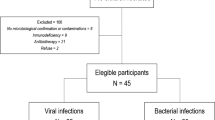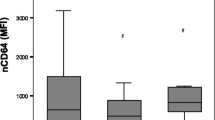Abstract
Purpose
CD64 expression on the surface of neutrophils has recently been proposed as an early marker of bacterial infection. The goal of this study was to determine whether the CD64 index allows differentiation of bacterial sepsis from viral and fungal sepsis and other inflammatory states in a critical-care setting.
Methods
This was an observational prospective study conducted in a medical ICU of a university hospital. All patients admitted between September 2009 and March 2010 with at least two criteria for systemic inflammatory response syndrome (SIRS) were eligible for inclusion. Upon admission, hematological exams were conducted by flow cytometry, allowing quantification of CD64 expression (Leuko64™ kit, Trillium Diagnostics LLC, USA). ROC curve analysis was performed to evaluate the utility of the CD64 index in the diagnosis of bacterial infection. Patients with suspected infection were excluded when infection could not be microbiologically confirmed.
Results
Our study included 293 patients with a SAPS II score of 45 (31–59). Bacterial infection was found in 148 patients and SIRS or non-bacterial infection was documented in 145 patients. A CD64 index greater than 2.2 predicted bacterial infection with a sensitivity and specificity of 63% (55–71%) and 89% (83–94%), respectively. The area under the ROC curve was 0.8 (0.75–0.84). Positive and negative likelihood ratios were 5.7 (5.0–6.5) and 0.4 (0.3–0.7), respectively.
Conclusions
The CD64 index is specific for bacterial infection among ICU patients. As a result of its weak sensitivity, the CD64 index may not be practically recommended, but it may be useful in combination with a more sensitive biological marker.



Similar content being viewed by others
References
Angus DC, Linde-Zwirble WT, Lidicker J, Clermont G, Carcillo J, Pinsky MR (2001) Epidemiology of severe sepsis in the United States: analysis of incidence, outcome, and associated costs of care. Crit Care Med 29:1303–1310
Kumar A, Roberts D, Wood KE, Light B, Parrillo JE, Sharma S, Suppes R, Feinstein D, Zanotti S, Taiberg L, Gurka D, Cheang M (2006) Duration of hypotension before initiation of effective antimicrobial therapy is the critical determinant of survival in human septic shock. Crit Care Med 34:1589–1596
Peters RP, van Agtmael MA, Danner SA, Savelkoul PH, Vandenbroucke-Grauls CM (2004) New developments in the diagnosis of bloodstream infections. Lancet Infect Dis 4:751–760
Uzzan B, Cohen R, Nicolas P, Cucherat M, Perret GY (2006) Procalcitonin as a diagnostic test for sepsis in critically ill adults and after surgery or trauma: a systematic review and meta-analysis. Crit Care Med 34:1996–2003
Tang BM, Eslick GD, Craig JC, McLean AS (2007) Accuracy of procalcitonin for sepsis diagnosis in critically ill patients: systematic review and meta-analysis. Lancet Infect Dis 7:210–217
Mongardon N, Lemiale V, Perbet S, Dumas F, Legriel S, Guerin S, Charpentier J, Chiche JD, Mira JP, Cariou A (2010) Value of procalcitonin for diagnosis of early onset pneumonia in hypothermia-treated cardiac arrest patients. Intensive Care Med 36:92–99
Jiyong J, Tiancha H, Wei C, Huahao S (2009) Diagnostic value of the soluble triggering receptor expressed on myeloid cells-1 in bacterial infection: a meta-analysis. Intensive Care Med 35:587–595
Davis BH, Olsen SH, Ahmad E, Bigelow NC (2006) Neutrophil CD64 is an improved indicator of infection or sepsis in emergency department patients. Arch Pathol Lab Med 130:654–661
Icardi M, Erickson Y, Kilborn S, Stewart B, Grief B, Scharnweber G (2009) CD64 index provides simple and predictive testing for detection and monitoring of sepsis and bacterial infection in hospital patients. J Clin Microbiol 47:3914–3919
Groselj-Grenc M, Ihan A, Pavcnik-Arnol M, Kopitar AN, Gmeiner-Stopar T, Derganc M (2009) Neutrophil and monocyte CD64 indexes, lipopolysaccharide-binding protein, procalcitonin and C-reactive protein in sepsis of critically ill neonates and children. Intensive Care Med 35:1950–1958
Bhandari V, Wang C, Rinder C, Rinder H (2008) Hematologic profile of sepsis in neonates: neutrophil CD64 as a diagnostic marker. Pediatrics 121:129–134
Cardelli P, Ferraironi M, Amodeo R, Tabacco F, De Blasi RA, Nicoletti M, Sessa R, Petrucca A, Costante A, Cipriani P (2008) Evaluation of neutrophil CD64 expression and procalcitonin as useful markers in early diagnosis of sepsis. Int J Immunopathol Pharmacol 21:43–49
Hsu KH, Chan MC, Wang JM, Lin LY, Wu CL (2011) Comparison of Fcgamma receptor expression on neutrophils with procalcitonin for the diagnosis of sepsis in critically ill patients. Respirology 16:152–160
Levy MM, Fink MP, Marshall JC, Abraham E, Angus D, Cook D, Cohen J, Opal SM, Vincent JL, Ramsay G (2003) 2001 SCCM/ESICM/ACCP/ATS/SIS International Sepsis Definitions Conference. Crit Care Med 31:1250–1256
Groselj-Grenc M, Ihan A, Derganc M (2008) Neutrophil and monocyte CD64 and CD163 expression in critically ill neonates and children with sepsis: comparison of fluorescence intensities and calculated indexes. Mediators Inflamm 2008:202646
Martin C, Garnier F, Vallet B (2005) Recommendations for management of severe sepsis and septic shock. Surviving Sepsis Campaign. Ann Fr Anesth Reanim 24:440–443
Cohen J, Brun-Buisson C, Torres A, Jorgensen J (2004) Diagnosis of infection in sepsis: an evidence-based review. Crit Care Med 32:S466–S494
Cid J, Aguinaco R, Sanchez R, Garcia-Pardo G, Llorente A (2010) Neutrophil CD64 expression as marker of bacterial infection: a systematic review and meta-analysis. J Infect 60:313–319
Gamez-Diaz LY, Enriquez LE, Matute JD, Velasquez S, Gomez ID, Toro F, Ospina S, Bedoya V, Arango CM, Valencia ML, De La Rosa G, Gomez CI, Garcia A, Patino PJ, Jaimes FA (2011) Diagnostic accuracy of HMGB-1, sTREM-1, and CD64 as markers of sepsis in patients recently admitted to the emergency department. Acad Emerg Med 18:807–815
Nuutila J (2010) The novel applications of the quantitative analysis of neutrophil cell surface FcgammaRI (CD64) to the diagnosis of infectious and inflammatory diseases. Curr Opin Infect Dis 23:268–274
Livaditi O, Kotanidou A, Psarra A, Dimopoulou I, Sotiropoulou C, Augustatou K, Papasteriades C, Armaganidis A, Roussos C, Orfanos SE, Douzinas EE (2006) Neutrophil CD64 expression and serum IL-8: sensitive early markers of severity and outcome in sepsis. Cytokine 36:283–290
Acknowledgments
The authors thank BH Davis (Trillium Diagnostics, Brewer, ME, USA) for supplying reagents.
Conflicts of interest
None.
Author information
Authors and Affiliations
Corresponding author
Additional information
A. Gros and M. Roussel contributed equally to this study.
Rights and permissions
About this article
Cite this article
Gros, A., Roussel, M., Sauvadet, E. et al. The sensitivity of neutrophil CD64 expression as a biomarker of bacterial infection is low in critically ill patients. Intensive Care Med 38, 445–452 (2012). https://doi.org/10.1007/s00134-012-2483-6
Received:
Accepted:
Published:
Issue Date:
DOI: https://doi.org/10.1007/s00134-012-2483-6




